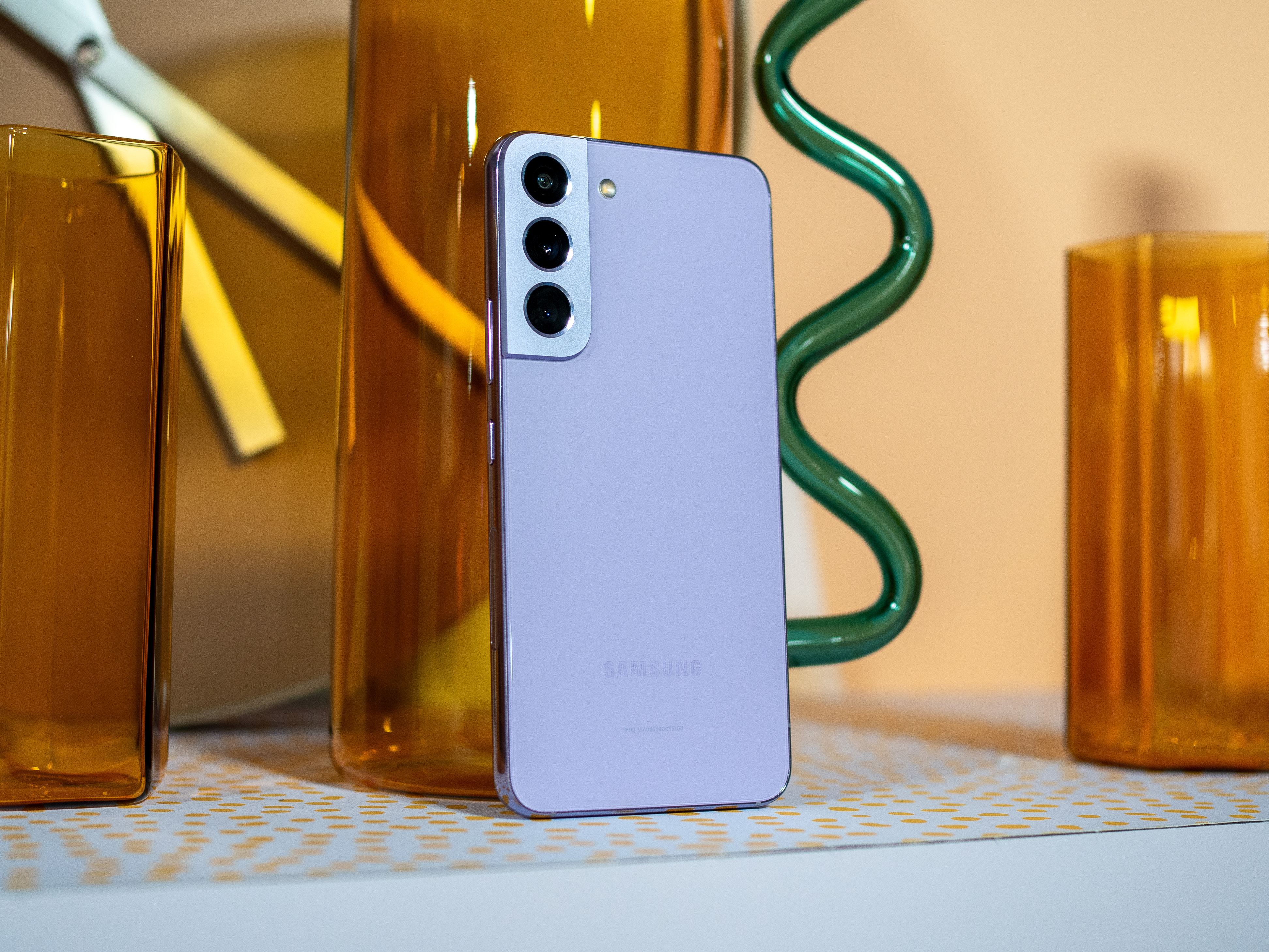
His Samsung Galaxy S22 He is now at least two years old. Are you thinking about upgrading your smartphone to Galaxy S24? A new processor, Galaxy AI implementation, fresh colors and other upgrades could make this a tempting proposition.
However, it’s really worth it Is the $800 price worth it if you already have a Galaxy S22? Here’s what you need to know before you make your decision.
Samsung Galaxy S24 vs. Galaxy S22: characteristics
| Galaxy S24 | Galaxy S22 | |
| Weight | 168.0 g (5.93 oz) | 167.3 g (5.9 oz) |
| Dimensions | 147 x 70.6 x 7.6 mm (5.79 x 2.78 x 0.30 in) | 144.78 x 70.61 x 7.62 mm (5.7 x 2.8 x 0.3 in) |
| Screen size, characteristics | 6.2-inch screen with 2 dynamic AMOLED glasses, scratch-resistant (Corning Gorilla Glass Victus 2) | 6.1-inch Dynamic AMOLED screen with 2 scratch-resistant glass (Corning Gorilla Glass Victus) |
| Screen resolution | Resolution 2340 x 1080 pixels, aspect ratio 19.5:9, refresh rate 416 ppi, 120 Hz.
Maximum brightness 2600 nits |
2340 x 1080 pixels, 19.5 ratio, 422 PPI, 120 Hz refresh rate.
Maximum brightness 1500 nits |
| OS | Android 14 | Android 13 |
| Storage | 128 GB or 256 GB | 128 GB or 256 GB |
| CPU | Qualcomm Snapdragon 8 3rd generation | Qualcomm Snapdragon 8 Gen 1 |
| RAM | 8 GB | 8 GB |
| Camera | Main 50 MP, ultra-wide angle ƒ/1.8 12 MP, telephoto lens ƒ/2.2 10 MP, ƒ/2.43x optical zoom, front |
50 MP wide angle, f/1.8 Ultra wide angle 12 MP, f/2.2 Telephoto lens 10 MP, f/2.4with 3x optical zoom 10 MP front, f/2.2 |
| video | 7680×4320 (8K UHD) (30 fps) 3840×2160 (4K UHD) (60 fps)
1920×1080 (Full HD) (240 fps) |
7680×4320 (8K UHD) (24 fps) 3840×2160 (4K UHD) (60 fps)
1920×1080 (Full HD) (240 fps) 1280×720 (HD) (960 fps) |
| galaxy ai | Yeah | No |
| Endurance | IP68 | IP68 |
| Battery |
4000 mAh
Wired charging 25W
Wireless charging 15W
Reverse wireless charging 4.5W
|
Wired charging 3700 mAh, 25 W
Wireless charging 15W Reverse wireless charging 4.5W |
| Colors | Black Onyx, Marble Grey, Cobalt Violet, Amber Yellow, Jade Green, Sandstone Orange, Sapphire Blue | Phantom Black, Phantom White, Green, Rose Gold, Boron Purple |
| Price | From $800 | From $800 (initially) |
Samsung Galaxy S24 vs. Galaxy S22: design and screen
There are some design differences between the 2022 Galaxy S22 and the 2024 Galaxy S24. The screen size has increased from 6.1 to 6.2 inches, but both models feature Dynamic AMOLED 2X displays with a 120Hz refresh rate. The Galaxy S24 has a brighter display. with a maximum brightness of 2600 nits compared to 1500 nits for the Galaxy S22. Additionally, the Galaxy S24 comes with Corning Gorilla Glass Victus 2, while the Galaxy S22 comes with Corning Gorilla Glass Victus. A brighter and more durable screen isn’t enough of a reason to upgrade, but it’s certainly nice to have.
In terms of bezel design, the Galaxy S24 has a more streamlined look with thinner bezels that provide an almost edge-to-edge viewing experience. In contrast, the Galaxy S22 has slightly thicker bezels.
As for the rest of the design, these are two smartphones. very beautiful similar. The S22 has a more rounded and glossy frame compared to the flat matte frame of the S24, but otherwise it’s pretty clear that the two phones are close brothers.
Samsung Galaxy S24 vs. Galaxy S22: performance and battery
The smartphone chipset is the processor of the phone that provides all its functions and capabilities. The Galaxy S24 is powered by an upgraded Qualcomm Snapdragon 8 Gen 3 chip. In contrast, the Galaxy S22 is powered by a Qualcomm Snapdragon 8 Gen 1 chip. This brings improved performance, with benchmarks showing the Gen 3 chip delivering 30% more CPU performance and around 25% more GPU performance processor compared to its predecessor. The Gen 3 chip is also more power efficient, resulting in longer battery life for users.
Ultimately, this is one of the biggest differences between the two phones. While the Snapdragon 8 Gen 1 isn’t a bad chip in 2024, the Snapdragon 8 Gen 3 should be noticeably better, whether in power or better battery efficiency. If you find that your S22 is slower than you’d like and/or doesn’t last as long during the day as you need it to, you may want to consider upgrading your S24.
Samsung Galaxy S24 vs. Galaxy S22: cameras
Basic models Galaxy S22 and Galaxy S24 The camera configuration remains virtually the same. Galaxy S24 is equipped with a 50 MP main camera, a 12 MP ultra lens and a 10 MP telephoto lens with 3x optical zoom. Its front camera has a resolution of 12 megapixels.
The older Galaxy S22 also features a 50 MP main camera, a 12 MP ultra-wide-angle lens and a 10 MP telephoto lens with similar optical zoom capabilities. The front camera resolution is 10 megapixels.
Since the technical specifications of the cameras of these models are similar, the differences in image quality are very minimal. However, advances in sensor technology have led to improved low-light performance. And the Galaxy S24’s new imaging software offers improved color accuracy, noise reduction capabilities, and HDR processing over its predecessor.
There’s no doubt that you’ll be able to take better photos with the Galaxy S24 than what your Galaxy S22 is capable of, but don’t expect a revolutionary upgrade.
Samsung Galaxy S24 vs. Galaxy S22: Galaxy AI
The latest Galaxy S24 series, which also includes the Galaxy S24 Plus and Galaxy S24 Ultra, features AI capabilities that make it stand out from the crowd. A standout feature is Circle to Search, which lets you search for images by circling them on the screen. Additionally, Live Translate offers real-time translations and transcriptions during conversations with people speaking different languages.
Notes Assist is a feature of S24 that helps you summarize text. And the generative editing feature allows you to use photo editing techniques such as moving objects in photos and removing unnecessary elements.
Samsung has confirmed that Galaxy AI features will come to the Galaxy S22 this May, although an exact release date has not been announced.
Samsung Galaxy S24 vs Galaxy S22: Software Updates
Companies like Samsung and Google are becoming much more generous when it comes to promised updates to Android and software in general. For example, the Galaxy S24 ships with Android 14 but offers seven years of Android updates and security patches. This means the Galaxy S24 should stay up to date with the latest features and security patches until at least 2031.
In contrast, the Galaxy S22 came with Android 13 and promised four years of major Android updates. This means you still have a couple of years of support to look forward to, but the Galaxy S24 will clearly last longer in this regard.
Samsung Galaxy S24 vs. Galaxy S22: price and availability
Between the release of the Samsung Galaxy S22 and S24, Samsung did not increase the prices of its smartphones. That puts the S24 at $800, which is the same as the S22’s starting price.
The Galaxy S24 is available in four colors: Onyx Black, Marble Grey, Cobalt Violet and Amber Yellow. Samsung’s website offers three exclusive colors: Jade Green, Sapphire Blue and Sandstone Orange. It comes in 128GB or 256GB storage options and is available to purchase now.
When the Galaxy S22 launched, it was available in Onyx Black, Marble Gray, Cobalt Violet, Amber Yellow, Jade Green, Sandstone Orange, and Sapphire Blue colors.
Samsung Galaxy S24 vs. Galaxy S22: is it worth upgrading?
If you’re the proud owner of a Galaxy S22 and aren’t hankering for an upgrade, there’s little to force you to do so. The phones are almost the same size and feature a similar camera system. If your S22 is not giving you any problems, continue to use it and enjoy it.
But if you have money to spare or your Galaxy S22 is giving you problems, the Galaxy S24 is an easy recommendation. It’s faster, its battery lasts longer, its cameras are slightly better, and its screen is easier to see in bright sunlight. Is not amazing updates, but updates nonetheless.
And that’s really what it comes down to. Are you still loving your Galaxy S22? If so, don’t feel the need to replace it with the S24. But if you want a phone similar to your current S22, but a little better in a few ways, the S24 won’t disappoint.

Source: Digital Trends













